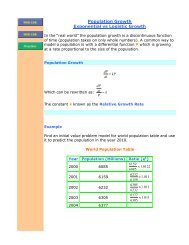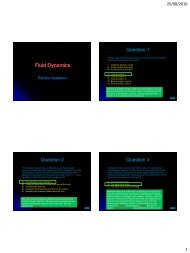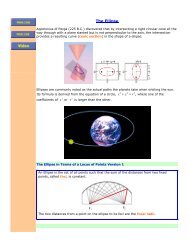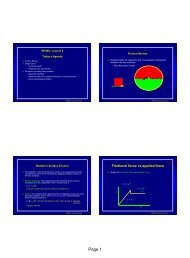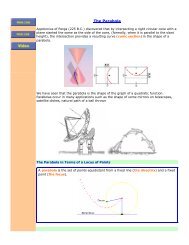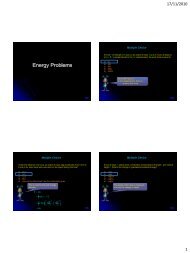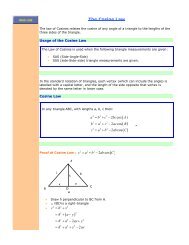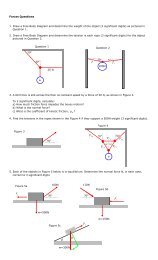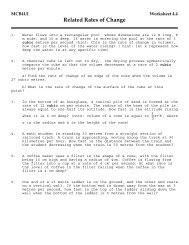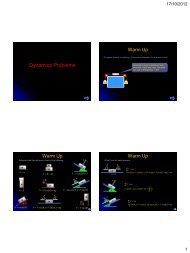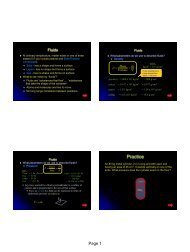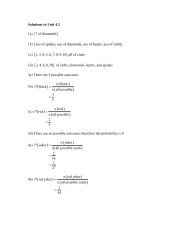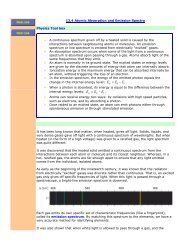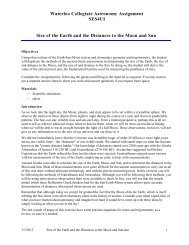Using Centre of Mass to Help Solve Two Dimensional Momentum ...
Using Centre of Mass to Help Solve Two Dimensional Momentum ...
Using Centre of Mass to Help Solve Two Dimensional Momentum ...
Create successful ePaper yourself
Turn your PDF publications into a flip-book with our unique Google optimized e-Paper software.
Elastic Collisions<br />
Definition:<br />
• two point masses on which no external forces<br />
act collide without losing any energy.<br />
m<br />
1<br />
v 1 m 2<br />
Prerequisites:<br />
θ 1<br />
θ 2<br />
m<br />
2<br />
m<br />
1<br />
• collisions in one dimension<br />
• conservation <strong>of</strong> momentum and energy<br />
w<br />
2<br />
w<br />
1<br />
• occurs frequently in everyday applications<br />
Summary:<br />
The scattering angles and the target’s final speed<br />
are given by<br />
where<br />
w 2<br />
v 1<br />
=<br />
cos θ 1 = ( 1 + α ) β 2 + 1 − α<br />
2 β<br />
1 − β 2<br />
α<br />
Go <strong>to</strong> derivation.<br />
and cos θ 2 = 1 + α<br />
2<br />
α = m 2<br />
m 1<br />
and β = w 1<br />
v 1<br />
.<br />
,<br />
w 2<br />
v 1<br />
Why study it<br />
• illustrates conservation laws<br />
• illustrates center <strong>of</strong> mass frame<br />
Go <strong>to</strong> Java applet
Scattering in two dimensions<br />
Let’s apply conservation <strong>of</strong> momentum and energy<br />
<strong>to</strong> a non-trivial problem: the elastic scattering<br />
<strong>of</strong> one body <strong>of</strong>f another (elastic means no<br />
energy is lost in the collision).<br />
m<br />
1<br />
v 1 m 2<br />
θ 1<br />
θ 2<br />
m<br />
2<br />
m<br />
1<br />
w<br />
2<br />
w<br />
1<br />
We will suppose body 2 (the target), is initially<br />
at rest.<br />
Conservation <strong>of</strong> energy<br />
1<br />
2 m 1 v 2<br />
1 = 1<br />
2 m 1 w 2<br />
1 + 1<br />
2 m 2 w 2<br />
2 .<br />
Conservation <strong>of</strong> momentum parallel <strong>to</strong> v 1<br />
m 1 v 1 = m 1 w 1 cos θ 1 + m 2 w 2 cos θ 2 .<br />
Conservation <strong>of</strong> momentum perpendicular <strong>to</strong> v 1<br />
m 1 w 1 sin θ 1 = m 2 w 2 sin θ 2 .<br />
Without loss <strong>of</strong> generality, we may take w 1<br />
and<br />
w 2<br />
<strong>to</strong> be positive, and the scattering angles <strong>to</strong> lie<br />
between 0 and π.<br />
You may recall our earlier treatment <strong>of</strong> a collision<br />
in one dimension. There, there were two<br />
equations in two unknowns, the final speeds.<br />
The final speeds were therefore fixed, once the<br />
initial speeds were known.<br />
Here, we have three equations in four unknowns,<br />
the two final speeds and the two scattering<br />
angles. Therefore, we won’t be able <strong>to</strong> solve for<br />
them all. Let’s regard w 1<br />
as a variable, and solve<br />
for the other three in terms <strong>of</strong> w 1<br />
.<br />
Let’s solve for θ 1<br />
(leaving θ 2<br />
and w 2<br />
as exercises).<br />
We do this in several steps, which we<br />
won’t reproduce here.<br />
1) Eliminate θ 2<br />
from the two momentum equations<br />
by solving them for cos θ 2<br />
and sin θ 2<br />
, and<br />
then using the identity cos 2 θ 2<br />
+ sin 2 θ 2<br />
= 1.<br />
2) Eliminate w 2<br />
by solving the energy equation<br />
for w 2 2<br />
and substituting it in<strong>to</strong> the result <strong>of</strong> the<br />
first step.<br />
3) <strong>Solve</strong> the resulting equation for cos θ 1<br />
. The result<br />
is
cos θ 1 = ( 1 + α ) β 2 + 1 − α<br />
2 β ,<br />
where we have introduced two abbreviations:<br />
α = m 2<br />
m 1<br />
,<br />
which tells the relative sizes <strong>of</strong> the two masses,<br />
and<br />
β = w 1<br />
v 1<br />
,<br />
which just gives w 1<br />
in units <strong>of</strong> v 1<br />
. Here is a plot<br />
<strong>of</strong> θ 1<br />
for various values <strong>of</strong> the mass ratio:<br />
(target mass less than projectile mass, an uncommon<br />
situation) then there is a maximum <strong>of</strong><br />
the scattering angle θ 1<br />
. It is easy <strong>to</strong> show that it<br />
is given by<br />
sin θ max<br />
1 = α<br />
For scattering through angles less than this, there<br />
are actually two values <strong>of</strong> the final speed for a<br />
given value <strong>of</strong> θ 1<br />
. The next figure shows the<br />
momenta in a typical case (α=1/√2, θ 1<br />
=π/6). The<br />
two red lines correspond <strong>to</strong> one solution, and the<br />
two blue lines correspond <strong>to</strong> the other.<br />
.<br />
π<br />
α>1<br />
θ 1<br />
α=1<br />
α
where T<br />
1<br />
is the energy <strong>of</strong> the incoming body 1.<br />
Here is a movie <strong>of</strong> the process represented by the<br />
two red lines, and another movie <strong>of</strong> the process<br />
shown in green. Links <strong>to</strong> movies showing the<br />
same processes in the center <strong>of</strong> mass frame will<br />
be provided later.<br />
Another interesting point is that for all values <strong>of</strong><br />
α, there is a minimum value <strong>of</strong> the final speed <strong>of</strong><br />
the projectile. It is given by<br />
w min<br />
1<br />
v 1<br />
= m 1 − m 2<br />
m 1 + m 2 .<br />
This minimum occurs at θ 1<br />
=0 when α1. It corresponds <strong>to</strong> a maximum<br />
amount <strong>of</strong> kinetic energy transferred <strong>to</strong> body 2:<br />
T max<br />
2 =<br />
4 m 1 m 2<br />
( m 1 + m 2 ) 2 T 1<br />
,<br />
In cases where the incoming mass m 1<br />
is much<br />
less than the target mass m 2<br />
(as <strong>of</strong>ten happens in<br />
fixed-targed particle physics experiments), the<br />
fac<strong>to</strong>r multiplying T 1<br />
on the right-hand side is<br />
much less than 1, and not very much <strong>of</strong> the<br />
incident particle’s energy can be transferred <strong>to</strong><br />
the target.<br />
Exercise:<br />
Show that the speed w 2<br />
and angle θ 2<br />
<strong>of</strong> the target<br />
after the collision are given by<br />
w 2<br />
v 1<br />
=<br />
1 − β 2<br />
α<br />
and cos θ 2 = 1 + α<br />
2<br />
w 2<br />
v 1 .<br />
Analysis in the center <strong>of</strong> mass frame<br />
In our section on the center <strong>of</strong> mass frame, we<br />
show that this frame is special because the sum<br />
<strong>of</strong> the momenta in this frame is zero. This allows<br />
us <strong>to</strong> simplify the analysis considerably. In the<br />
following, we’ll denote momenta in the center <strong>of</strong><br />
mass frame by primes.<br />
There are only two momenta before the collision,<br />
so they are equal and opposite in the center <strong>of</strong><br />
mass frame:
p P 2 N = − p P 1 N .<br />
There are only two momenta after the collision<br />
(we’ll call them q P 1<br />
and q P 2<br />
), which are also equal<br />
and opposite <strong>to</strong> one another in the center <strong>of</strong> mass<br />
frame:<br />
q P 2 N = − q P 1 N .<br />
We now apply conservation <strong>of</strong> energy in the<br />
center <strong>of</strong> mass frame:<br />
p P 1<br />
N 2<br />
+ p P 2<br />
N 2<br />
= q P 1<br />
N 2<br />
+ q P 2<br />
N 2<br />
.<br />
2 m 1 2 m 2 2 m 1 2 m 2<br />
We thus find that the magnitudes <strong>of</strong> the momenta<br />
in the center <strong>of</strong> mass frame do not change during<br />
the collision:<br />
q P 1 N = p P 1 N and q P 2 N = p P 2 N .<br />
Since the masses <strong>of</strong> the bodies don’t change<br />
during the collision, we therefore conclude that<br />
the speeds don’t change, when viewed in the<br />
center <strong>of</strong> mass frame. Only the direction <strong>of</strong><br />
motion changes. Here are the diagrams:<br />
lab frame<br />
m<br />
1<br />
v 1 m 2<br />
θ 1<br />
θ 2<br />
v cm<br />
center <strong>of</strong> mass frame<br />
m 1<br />
m 2<br />
m<br />
2<br />
m<br />
1<br />
m 1<br />
v 1 θ N<br />
θ N v<br />
cm<br />
m 2<br />
v cm<br />
N<br />
v 1<br />
N<br />
w<br />
2<br />
w<br />
1<br />
In labelling the second diagram, we have already<br />
used the facts that the speed <strong>of</strong> the target is v cm<br />
,<br />
that the final speeds are the same as the initial<br />
speeds, and that the final velocities are back-<strong>to</strong>back<br />
in the center <strong>of</strong> mass frame. Much <strong>of</strong> our<br />
work is already done.<br />
The final speeds do not depend on the scattering<br />
angle θ N in the center <strong>of</strong> mass frame. The angular<br />
dependence <strong>of</strong> the final speeds in the lab<br />
frame comes in when we transform between the
two frames:<br />
x-component <strong>of</strong> final velocity <strong>of</strong> projectile:<br />
w 1<br />
cos θ 1<br />
= v 1<br />
N cos θ N + v cm<br />
y-component <strong>of</strong> final velocity <strong>of</strong> projectile:<br />
w 1<br />
sin θ 1<br />
= v 1<br />
N sin θ N .<br />
In order <strong>to</strong> compare these processes in the two<br />
frames, here is a movie <strong>of</strong> the process represented<br />
by the two red lines as seen in the lab<br />
frame, and another <strong>of</strong> the same process as seen<br />
in the center <strong>of</strong> mass frame. And here is a movie<br />
<strong>of</strong> the process shown in green in the lab frame,<br />
and another in the center <strong>of</strong> mass frame.<br />
We easily calculate from their definitions<br />
v cm<br />
= m 1 v 1<br />
m 1<br />
+ m 2<br />
and v 1<br />
N = m 2 v 1<br />
m 1<br />
+ m 2<br />
.<br />
We solve the two velocity transformation equations<br />
for cos θ N and sin θ N , and then eliminate θ N<br />
using the identity cos 2 θ N + sin 2 θ N =1. Solving<br />
the resulting equation for cos θ 1<br />
yields the same<br />
result as before.<br />
Here are the momenta <strong>of</strong> some typical scatterings<br />
as seen in the lab frame:
<strong>Momentum</strong> and conservation laws<br />
The concept <strong>of</strong> momentum in three dimensions<br />
is not materially different from that in one dimension.<br />
The momentum vec<strong>to</strong>r <strong>of</strong> a body is its mass<br />
times its velocity vec<strong>to</strong>r:<br />
p P = m v P .<br />
Suppose we have a many-body system. In such<br />
systems, the concept <strong>of</strong> momentum becomes<br />
particularly useful. Let’s see why.<br />
In general, two kinds <strong>of</strong> forces can act on the<br />
bodies in the system. There are internal forces<br />
between the bodies, and external forces acting on<br />
individual bodies.<br />
In what follows, we will make a specific<br />
assumption about the nature <strong>of</strong> the forces acting<br />
between bodies. We will assume that they satisfy<br />
New<strong>to</strong>n’s “third law”:<br />
The force <strong>of</strong> body j on body i is equal in<br />
magnitude and opposite in direction <strong>to</strong> the force<br />
<strong>of</strong> body i on body j.<br />
(Here, i and j stand for numbers which label the<br />
bodies.) This means that if the subsystem containing<br />
only those two bodies were placed in isolation<br />
(no external forces acting), then no net<br />
force would act on it.<br />
Although this may seem obvious, it does not hold<br />
for all types <strong>of</strong> force. New<strong>to</strong>n’s third law is not a<br />
law at all; it is just a description <strong>of</strong> a “nice” kind<br />
<strong>of</strong> force.<br />
We’ll symbolize the force on body i due <strong>to</strong> body<br />
j by F P<br />
ij<br />
. Then the third law looks like this in<br />
pictures:<br />
P 1<br />
3 F P = −<br />
31<br />
F P<br />
F<br />
13<br />
and like this in symbols:<br />
F P<br />
ij<br />
= − F P<br />
ji<br />
.<br />
2<br />
We’ll assume that a body exerts no force on<br />
itself, so F P<br />
ii<br />
= 0 . (This is contained in the above<br />
equation.)<br />
Let’s also let F P<br />
i<br />
be the external force acting on<br />
body i. We make no assumptions about its nature.<br />
Then New<strong>to</strong>n’s second law applied <strong>to</strong> body<br />
i reads<br />
4<br />
13
m i<br />
a P i<br />
= F<br />
P<br />
i<br />
+ 3<br />
j<br />
F P . ij<br />
The right-hand side is the sum <strong>of</strong> the external<br />
force and all the internal forces acting on body i.<br />
Now let’s consider the <strong>to</strong>tal momentum <strong>of</strong> the<br />
system; it is the sum <strong>of</strong> the individual momenta:<br />
p P <strong>to</strong>t<br />
= 3 m i<br />
v P i<br />
.<br />
i<br />
How does the <strong>to</strong>tal momentum change in time<br />
d<br />
dt 3 m i<br />
v P i<br />
= 3 m i<br />
a P i<br />
= 3 F P<br />
i<br />
+ 3 F P<br />
ij .<br />
i i i i , j<br />
The second term on the right-hand side is zero<br />
because the forces, taken in pairs, cancel out by<br />
New<strong>to</strong>n’s “third law”. Hence, we find<br />
d p P <strong>to</strong>t<br />
dt<br />
= F P<br />
ext ,<br />
where the sum <strong>of</strong> the external forces acting on<br />
the system is<br />
F P<br />
ext<br />
= 3 F P<br />
i<br />
.<br />
The internal forces have no effect on the rate <strong>of</strong><br />
change <strong>of</strong> the <strong>to</strong>tal momentum. Now let’s<br />
suppose that the <strong>to</strong>tal force acting on the system<br />
i<br />
is zero. Then we have a conservation law:<br />
d p P <strong>to</strong>t<br />
= 0 .<br />
dt<br />
This is not as trivial as it might seem, because it<br />
is true even when the internal forces are nonzero.<br />
The only thing that can change the <strong>to</strong>tal momentum<br />
is a nonzero <strong>to</strong>tal external force on the<br />
system.<br />
The center <strong>of</strong> mass frame<br />
Suppose you have an object made up <strong>of</strong> several<br />
smaller bodies connected <strong>to</strong>gether somehow.<br />
You <strong>to</strong>ss this composite body in<strong>to</strong> the air,<br />
possibly giving it some spin and giving the<br />
consituents some nontrivial internal motions.<br />
The resulting motion can be rather complicated.<br />
As is <strong>of</strong>ten done in physics, we would like <strong>to</strong> find<br />
some aspect <strong>of</strong> the net motion which is simple.<br />
You have probably already guessed what this<br />
aspect is, especially after having studied the<br />
center <strong>of</strong> mass in one dimension. The whole<br />
thing carries over very easily in<strong>to</strong> three dimensions,<br />
the only change being that many quantities<br />
become vec<strong>to</strong>rs.<br />
We return <strong>to</strong> our equation for the rate <strong>of</strong> change<br />
<strong>of</strong> the <strong>to</strong>tal momentum <strong>of</strong> the system. Written in
terms <strong>of</strong> the position vec<strong>to</strong>rs, it reads<br />
d 2<br />
dt 2 3<br />
i<br />
m i<br />
P r i<br />
= F P<br />
ext .<br />
We can make this look like New<strong>to</strong>n’s law for a<br />
single body whose <strong>to</strong>tal mass is the sum <strong>of</strong> all the<br />
masses in the system, by multiplying and dividing<br />
by the <strong>to</strong>tal mass M:<br />
M d 2 P r cm<br />
= F P<br />
dt 2 ext<br />
where P r cm<br />
= 1<br />
M 3<br />
i<br />
m i<br />
P r i .<br />
The quantity P r cm<br />
is called the center <strong>of</strong> mass. It<br />
is the average <strong>of</strong> the positions <strong>of</strong> all the bodies,<br />
weighted by their masses.<br />
The above two equations say that the motion <strong>of</strong><br />
the center <strong>of</strong> mass <strong>of</strong> the system is the same as<br />
the motion <strong>of</strong> a single body<br />
• whose mass is equal <strong>to</strong> the <strong>to</strong>tal mass <strong>of</strong> the<br />
system;<br />
• which is located at the center <strong>of</strong> mass <strong>of</strong> the<br />
system; and<br />
• which is acted on by a force equal <strong>to</strong> the sum <strong>of</strong><br />
the external forces acting on the bodies <strong>of</strong> the<br />
system.<br />
In general, the center <strong>of</strong> mass moves as time goes<br />
on. The velocity <strong>of</strong> the center <strong>of</strong> mass is just the<br />
time derivative <strong>of</strong> r P cm<br />
, which is<br />
v P cm<br />
= 1<br />
M 3<br />
i<br />
m i<br />
v P i<br />
Now, let’s do a trick. We will view the whole<br />
system from a frame <strong>of</strong> reference which is moving<br />
along with velocity equal <strong>to</strong> the velocity <strong>of</strong><br />
the center <strong>of</strong> mass.<br />
Let’s say that a body is moving at 10 m s -1 in the<br />
original reference frame, and that the center <strong>of</strong><br />
mass is moving in the same direction at 6 m s -1 .<br />
Then the velocity <strong>of</strong> the body when viewed in the<br />
center <strong>of</strong> mass frame is 4 m s -1 . To get the<br />
velocity in the center <strong>of</strong> mass frame, you just<br />
subtract v P cm<br />
.<br />
We will symbolize quantities in the center <strong>of</strong><br />
mass frame by putting primes on them. Then<br />
v P i<br />
N = v P i<br />
− v P cm<br />
.<br />
The momentum <strong>of</strong> a body in the center <strong>of</strong> mass<br />
frame is just<br />
p P i<br />
N = m i<br />
v P i<br />
N = m i<br />
( v P i<br />
− v P cm<br />
) .<br />
Now for the punch line. We can show that the<br />
sum <strong>of</strong> the momenta in the center <strong>of</strong> mass frame<br />
is zero:
3 p N = 3 m i<br />
( v P i<br />
− v P cm<br />
)<br />
i<br />
P i<br />
i<br />
= 3 m i<br />
v P i<br />
− M v P cm<br />
i<br />
= 0 .<br />
The last line follows directly from the definition<br />
<strong>of</strong> the velocity <strong>of</strong> the center <strong>of</strong> mass.<br />
Energy and the center <strong>of</strong> mass frame<br />
An important property <strong>of</strong> the center <strong>of</strong> mass<br />
frame is that<br />
the <strong>to</strong>tal kinetic energy <strong>of</strong> a system is equal <strong>to</strong> the<br />
kinetic energy <strong>of</strong> the center <strong>of</strong> mass plus the sum<br />
<strong>of</strong> the kinetic energies <strong>of</strong> the bodies <strong>of</strong> the sytem,<br />
as calculated in the center <strong>of</strong> mass frame.<br />
The pro<strong>of</strong> is just a short calculation. <strong>Using</strong> the<br />
velocity transformation law<br />
v P i<br />
= v P cm<br />
+ v N ,<br />
P i<br />
3<br />
i<br />
1<br />
2 m i v P 2<br />
i = 1<br />
3<br />
2 m i ã ä v P 2<br />
cm + 2 v P cm A v P N + v P<br />
i i<br />
N 2 ë í<br />
i<br />
= 1<br />
2 ä å 3 m ë i ì v P 2<br />
cm + v P cm A 3 1<br />
m i<br />
v P i<br />
N + 3<br />
ã i í<br />
i i 2 m i v<br />
= 1<br />
2 M v P 2<br />
cm + 1<br />
3<br />
2 m i v P N 2 .<br />
i<br />
i<br />
P N 2<br />
i<br />
The first term on the last line is the kinetic<br />
energy <strong>of</strong> the center <strong>of</strong> mass. Another way <strong>to</strong><br />
write the last equation is<br />
T = T cm<br />
+ TN ,<br />
where T stands for kinetic energy.<br />
and the fact that the sum <strong>of</strong> the momenta in the<br />
center <strong>of</strong> mass frame is zero:<br />
we find<br />
3 m i<br />
v P i<br />
N = 0 ,<br />
i



